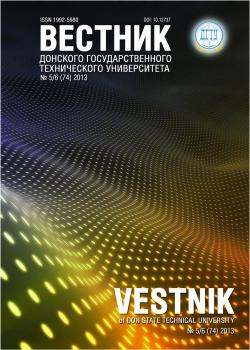The heat-flow rate and temperature of the heater are measured at various liquid subcooling boiling points. An experimental plant and the obtained results on the heat energy motion in the superfi-cially boiling binary liquid mixtures are described. The experi-ments have used a quasi-stationary heating method which allows accurate specifying of the critical heat flux (qkr) and the tempera-ture of the heater (Th). An experimental study of the superficial boiling has determined that the critical heat flux density depends significantly on the liquid subcooling. At the liquid nucleus temperature TL=30 0С in the mixture of water-n-butanol, 10% critical heat flux reaches a considerable size of 20.68 MW/m2, and at TL=30 0С – much less qkr=2.98 MW/m2. This is due to the increase in the temperature drop (∆Т =Th kr+TL) at the moment of qkr.
superficial boiling of mixtures, critical heat flux (qkr), temperature drop (∆Т)
Введение. Значительно увеличить производство электрической энергии возможно только за счет строительства или модернизации тепловых электростанций [1]. Все тепловые электростанции работают по циклу Ренкина, где в качестве рабочего тела можно использовать только пар. Большое количество пара получают при кипении, поэтому изучение процесса кипения представляет научный и практический интерес.
При нагреве кипящей жидкости обнаруживается критическая (максимальная) плотность теплового потока qкр [2], которая соответствует максимальной скорости пара, отходящего от поверхности нагрева. Цель работы — определить величину qкр и Тст кр при различных недогревах ядра жидкости.
1. Burov, V.D., Dorokhov, E.V., Yelizarov, D.P. Teplovye elektricheskie stantsii. [Thermal stations.] Moscow: Iz-datel´skiy dom MEI, 2009, 466 p. (in Russian).
2. Nukiyama, S. The maximum and minimum values of the heat Q transmitted from metal to boiling water under atmosphere pressure. Iht. J. Heat Mass Transfer, 1984, vol. 27, pp. 959-970.
3. Bonilla, C. Voprosy teploperedachi v yadernoy fizike. [Issues of heat transfer in nuclear physics.] Moscow: Gosatomizdat, 1961, 314 p. (in Russian).
4. Lykov, E. V. Thermoacoustic effects in surface boiling liquids. Int. J. Heat Mass Transfer, 1972, vol. 15, pp. 1603-1614.
5. Novikov, I.I. Perekhodnye rezhimy teploobmena pri kipenii zhidkosti. [Transient modes of heat transfer under fluid boiling.] Teplofizika vysokikh temperatur, 1996, vol. 34, no. 1, pp. 162-164 (in Russian).
6. Van Stralen, S. J. D. The mechanism of nucleate boiling in pure liquids and in binary mixtures-part I. Iht. J. Heat Mass Transfer, 1966, vol. 9, pp. 995-1020.
7. Van Stralen, S. J. D. The mechanism of nucleate boiling in pure liquids and in binary mixtures-part IV Surface boiling. Iht. J. Heat Mass Transfer, 1967, vol. 10, pp. 1485-1498.
8. Kruzhilin, G.N., et al., Nazmeyev, Y.G., ed. Teplofizika v teplovoy i yadernoy energetike. [Thermophysics in ther-mal- and nuclear-power engineering.] Kazan´: Kazan. fil. Mosk. energ. in-ta, 1998, 338 p. (in Russian).
9. Grigoryev, L.N., Usmanov, A.G. Teplootdacha pri kipenii binarnykh smesey. [Heat transfer under binary mixtures boiling.] Technical Physics, 1958, vol. 28, no. 2, pp. 325-332 (in Russian).
10. Alexandrov, А.А., Grigoryev, B.A. Tablitsy teplofizicheskikh svoystv vody i vodyanogo para. [Tables of thermo-physical properties of water and steam.] Moscow: Izdatel´stvo MEI, 1999, 168 p. (in Russian).
11. Collier, J., Hewitt, G. Vvedenie v yadernuyu energetiku. [Introduction to Nuclear Power.] Moscow: Energoatomiz-dat, 1989, 253 p. (in Russian).





